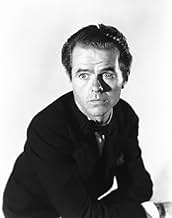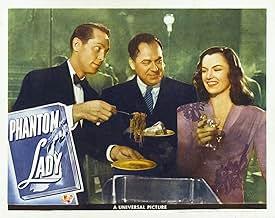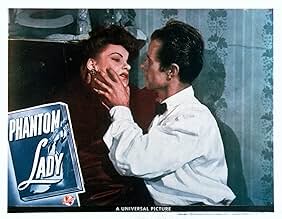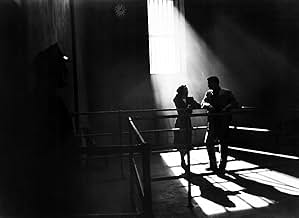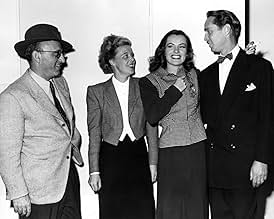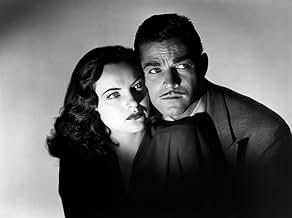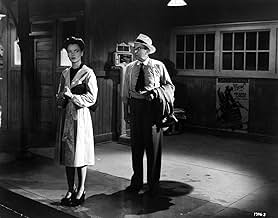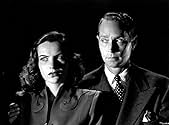VALUTAZIONE IMDb
7,2/10
6253
LA TUA VALUTAZIONE
Aggiungi una trama nella tua linguaA devoted secretary risks her life to try to find the elusive woman who may prove her boss didn't murder his selfish wife.A devoted secretary risks her life to try to find the elusive woman who may prove her boss didn't murder his selfish wife.A devoted secretary risks her life to try to find the elusive woman who may prove her boss didn't murder his selfish wife.
- Regia
- Sceneggiatura
- Star
Aurora Miranda
- Estela Monteiro
- (as Aurora)
Harry Adams
- Courtroom Spectator
- (non citato nei titoli originali)
Robert Bain
- Guitarist
- (non citato nei titoli originali)
Joan Bayley
- Dancer
- (non citato nei titoli originali)
Brandon Beach
- Theatre Party Guest
- (non citato nei titoli originali)
Brooks Benedict
- Theatre Party Guest
- (non citato nei titoli originali)
Recensioni in evidenza
So how did the producers get that orgasmic release scene past the censors. Sure, Carol (Raines) and Cliff (Cook) are about ten feet apart as he pounds on the drums while she sways back and forth in total sync, their faces contorted in frenzied delight. There's no guesswork here. It's as close to the real thing as the decade gets, and a masterpiece of simulated ecstasy. I wonder what the set was like while filming this.
The movie's a tight little thriller, helmed by noir master Robert Siodmak. So who is it that's framing architect Henderson (Curtis) for his wife's murder. By golly, the lovelorn Carol is going to find out even if it leads her down every dark, scary street on the studio lot. And once she dons her cheap hep-cat outfit, that's just where she's headed. But it's that frenzied jazz scene with Cliff that steals the show. Everything after seems something of an anti-climax. However, be sure to catch that beautifully modulated scene where Carol plies the emotionally disturbed Ann (Helm) for access to the incriminating ladies' hat. It's poignantly done, especially by actress Helm.
No doubt, this is one of the noir highpoints of the period, with dark symbolism and atmospheric shadows aplenty. Also, Raines gives a winning performance as the unstoppable Carol, while Tone wisely refuses to go over the top as the psychopath. On the other hand, it's a good thing we don't see much of Curtis in both a badly written and dimly performed part. I'm guessing Siodmak cared little how that particularly conventional role came across. Anyway, for fans of 40's noir, this Universal programmer remains a must-see.
The movie's a tight little thriller, helmed by noir master Robert Siodmak. So who is it that's framing architect Henderson (Curtis) for his wife's murder. By golly, the lovelorn Carol is going to find out even if it leads her down every dark, scary street on the studio lot. And once she dons her cheap hep-cat outfit, that's just where she's headed. But it's that frenzied jazz scene with Cliff that steals the show. Everything after seems something of an anti-climax. However, be sure to catch that beautifully modulated scene where Carol plies the emotionally disturbed Ann (Helm) for access to the incriminating ladies' hat. It's poignantly done, especially by actress Helm.
No doubt, this is one of the noir highpoints of the period, with dark symbolism and atmospheric shadows aplenty. Also, Raines gives a winning performance as the unstoppable Carol, while Tone wisely refuses to go over the top as the psychopath. On the other hand, it's a good thing we don't see much of Curtis in both a badly written and dimly performed part. I'm guessing Siodmak cared little how that particularly conventional role came across. Anyway, for fans of 40's noir, this Universal programmer remains a must-see.
Phantom Lady is quintessential Film Noir and a must-see for anyone who appreciates the genre. The film is not, nor does it aspire to be, a whodunit with an airtight plot, or a mystery-thriller that ends with an inconceivable twist as in the original novel. If that is what you want or expect, this is probably not your cup of tea. Although many great films considered part of the noir genre may include some of these elements, that's not what film noir is all about.
Film Noir is almost synonymous with Cornell Woolrich (William Irish), the author of the novel Phantom Lady. His novels and short stories are the source of an amazing number of screenplays and teleplays, including several noir and non-noir classics such as Hitchcock's Rear Window.
As a writer and persona, Woolrich was a uniquely noirish sort of guy. In fact, he wrote a series of six "Black" novels, all have been adapted to the screen or TV at least once, and some multiple times. Obviously, noir means black, and these black novels inspire great noir films.
Many Woolrich stories, Phantom Lady is one, revolve around impossible crimes. As sinister forces close in, his protagonists are powerless do anything but follow some diabolical labyrinth that defies understanding. No wonder his work is a perfect fit for film noir, which takes place in its own dark universe, where characters struggle against powerful and malevolent forces. Unfortunately, the nightmare scenarios created by Woolrich, enhanced by his own inimitable style of description, often seem to get lost in translation when brought to the silver screen. Although most of the films are very good, these adaptations tend to be very different from their literary source.
Not so with Phantom Lady – up to a point. Although details may vary, director Robert Siodmak cleverly and adroitly uses dazzling Expressionist visuals and quirky character performances to emulate the dreamlike quality of a Woolrich story. A good example is the incredible scene where Elisha Cook Jr. drums up the sexual overtones for Ella Raines.
Since our psychotic mastermind is revealed early on, there is no who-done-it mystery to distract the audience. The revelation allows a brilliant means of reworking the story into a tight and infinitely more interesting screenplay. Woolrich's original story follows a different approach, not confirming the killer until the end. Obviously, some treatments work better as a novel than a movie.
Often over-shadowed in the movies which he appears, this time Franchot Tone fits so perfectly into the role of Jack Marlow that we are captivated by his machinations, wondering where it will all end. All of the other characters are great and true to form as well. Raines is exceptionally strong in her portrayal of the somewhat naive love-struck secretary who won't give up.
True to a Woolrich novel, the genius of the film is in the telling of the story; more important than structure or even the ending. Although the outcome is the same, the ending is much different in the novel. Also, after the killer is revealed in the original story, there are 16 long pages, explaining every detail of every plot twist. Unfortunately, this approach is anticlimactic, and would never work as a film. Nevertheless, Siodmak is able to present a more convincing story with almost no explanation.
Any screen adaptation of a Woolrich story is always in jeopardy of being swallowed up by massive plot holes. After all, part of the charm of a Cornell Woolrich story is that you never really know if you dealing with reality, or trapped in a drug and alcohol induced nightmare.
In Phantom Lady, a character reveals, " I'd been blazing a reefer already before it happened, and you know what that does to you." Woolrich certainly did know, and much of his literature is obviously inspired by mind-bending experiences. If a screenwriter and director can artfully breach the massive plot chasms of an original Woolrich story, yet still preserve the beauty as in Phantom Lady, the film becomes a feast for any Film Noir fanatic.
Film Noir is almost synonymous with Cornell Woolrich (William Irish), the author of the novel Phantom Lady. His novels and short stories are the source of an amazing number of screenplays and teleplays, including several noir and non-noir classics such as Hitchcock's Rear Window.
As a writer and persona, Woolrich was a uniquely noirish sort of guy. In fact, he wrote a series of six "Black" novels, all have been adapted to the screen or TV at least once, and some multiple times. Obviously, noir means black, and these black novels inspire great noir films.
Many Woolrich stories, Phantom Lady is one, revolve around impossible crimes. As sinister forces close in, his protagonists are powerless do anything but follow some diabolical labyrinth that defies understanding. No wonder his work is a perfect fit for film noir, which takes place in its own dark universe, where characters struggle against powerful and malevolent forces. Unfortunately, the nightmare scenarios created by Woolrich, enhanced by his own inimitable style of description, often seem to get lost in translation when brought to the silver screen. Although most of the films are very good, these adaptations tend to be very different from their literary source.
Not so with Phantom Lady – up to a point. Although details may vary, director Robert Siodmak cleverly and adroitly uses dazzling Expressionist visuals and quirky character performances to emulate the dreamlike quality of a Woolrich story. A good example is the incredible scene where Elisha Cook Jr. drums up the sexual overtones for Ella Raines.
Since our psychotic mastermind is revealed early on, there is no who-done-it mystery to distract the audience. The revelation allows a brilliant means of reworking the story into a tight and infinitely more interesting screenplay. Woolrich's original story follows a different approach, not confirming the killer until the end. Obviously, some treatments work better as a novel than a movie.
Often over-shadowed in the movies which he appears, this time Franchot Tone fits so perfectly into the role of Jack Marlow that we are captivated by his machinations, wondering where it will all end. All of the other characters are great and true to form as well. Raines is exceptionally strong in her portrayal of the somewhat naive love-struck secretary who won't give up.
True to a Woolrich novel, the genius of the film is in the telling of the story; more important than structure or even the ending. Although the outcome is the same, the ending is much different in the novel. Also, after the killer is revealed in the original story, there are 16 long pages, explaining every detail of every plot twist. Unfortunately, this approach is anticlimactic, and would never work as a film. Nevertheless, Siodmak is able to present a more convincing story with almost no explanation.
Any screen adaptation of a Woolrich story is always in jeopardy of being swallowed up by massive plot holes. After all, part of the charm of a Cornell Woolrich story is that you never really know if you dealing with reality, or trapped in a drug and alcohol induced nightmare.
In Phantom Lady, a character reveals, " I'd been blazing a reefer already before it happened, and you know what that does to you." Woolrich certainly did know, and much of his literature is obviously inspired by mind-bending experiences. If a screenwriter and director can artfully breach the massive plot chasms of an original Woolrich story, yet still preserve the beauty as in Phantom Lady, the film becomes a feast for any Film Noir fanatic.
Seldom have my expectations been as often derailed as in The Phantom Lady. The plot--while a bit farfetched--is never boring or predictable. Although it's a smaller film than say, The Maltese Falcon or The Big Sleep, it is immensely satisfying.
Ella Raines is the real stand-out here. Not only is she great to look at (think half-way between Veronica Lake and Lauren Bacall) she also acts circles 'round the two leading men. Luminous, expressive yet subtle, she is perhaps a better actress than those two icons, if slightly less perfect-looking than Lake and a bit less magnetic than Bacall.
Thomas Gomez turns in a surprisingly complex and interesting performance, but don't expect too much from Franchot Tone. Although his acting abilities need no defense, he didn't do much with this role.
Sure, there are plot holes, a couple of contrived turns, and at least two ridiculous performances (Elisha Cook and Aurora Miranda) but all B Noir has its faults, and this one wins by dint of its unpredictability and pacing, and some great cinematography. Oh--and miss Raines.
Ella Raines is the real stand-out here. Not only is she great to look at (think half-way between Veronica Lake and Lauren Bacall) she also acts circles 'round the two leading men. Luminous, expressive yet subtle, she is perhaps a better actress than those two icons, if slightly less perfect-looking than Lake and a bit less magnetic than Bacall.
Thomas Gomez turns in a surprisingly complex and interesting performance, but don't expect too much from Franchot Tone. Although his acting abilities need no defense, he didn't do much with this role.
Sure, there are plot holes, a couple of contrived turns, and at least two ridiculous performances (Elisha Cook and Aurora Miranda) but all B Noir has its faults, and this one wins by dint of its unpredictability and pacing, and some great cinematography. Oh--and miss Raines.
I'll admit that I like a certain degree of plausibility in films. Thus, it was hard for me to totally embrace this movie after watching the scene in which the husband (Alan Curtis) comes home to his darkened apartment and calls out for his wife, wondering where she is,unaware that detectives were there waiting for him. It was obvious that Curtis expected the wife to be home, not to mention alive, yet the detectives never took this into consideration. If you strangled your spouse, would you return home later and call out for her? Besides, who could have tipped off the detectives that a murder had occurred? OK, if you get by these sore spots, you'll find a well-made film noir that is worth watching.
Robert Siodmak does a fabulous job with this B noir starring Ella Raines, Franchot Tone, and Alan Curtis. And he does it, I might add, without a lot of help from his male actors, i.e., Curtis and Tone. It's Raines all the way, a pretty, leggy actress who for one reason or another never reached the status of some of her "noir" counterparts.
Siodmak's use of sex, light, shadows, and music is truly remarkable as he tackles this genre. The shadows, lighting effects, and camera angles are all effective. But the highlight of the film takes place in a nightclub with a very sexual drum riff by Elisha Cook, egged on by an excited Raines. It's this scene that brings "Phantom Lady" into new territory.
Siodmak's commitment to the material is matched only by Raines, who gives a sincere performance as a woman in love trying to save her man. Franchot Tone phoned this one in. Alan Curtis didn't seem upset that he might die and didn't seem happy that he lived. And he never, except for a brief moment in prison, seemed to be in love with Raines.
The amusing thing about many of these films is that, as World War II progressed, interest in psychiatry deepened. But often the terms were used incorrectly in films such as "Possessed," "Spellbound," and "The Greatest Show on Earth." Tone is called paranoid by Thomas Gomez - Tone probably has some paranoia attached to his disorder, but he appears to be closer to a psychopath. In actuality, as evidenced by his headaches, he may have had a brain tumor pushing against his brain.
Phantom Lady doesn't have the greatest plot, but it's well worth watching.
Siodmak's use of sex, light, shadows, and music is truly remarkable as he tackles this genre. The shadows, lighting effects, and camera angles are all effective. But the highlight of the film takes place in a nightclub with a very sexual drum riff by Elisha Cook, egged on by an excited Raines. It's this scene that brings "Phantom Lady" into new territory.
Siodmak's commitment to the material is matched only by Raines, who gives a sincere performance as a woman in love trying to save her man. Franchot Tone phoned this one in. Alan Curtis didn't seem upset that he might die and didn't seem happy that he lived. And he never, except for a brief moment in prison, seemed to be in love with Raines.
The amusing thing about many of these films is that, as World War II progressed, interest in psychiatry deepened. But often the terms were used incorrectly in films such as "Possessed," "Spellbound," and "The Greatest Show on Earth." Tone is called paranoid by Thomas Gomez - Tone probably has some paranoia attached to his disorder, but he appears to be closer to a psychopath. In actuality, as evidenced by his headaches, he may have had a brain tumor pushing against his brain.
Phantom Lady doesn't have the greatest plot, but it's well worth watching.
Lo sapevi?
- QuizThe elusive phantom lady being sought by Carol "Kansas" Richman (Ella Raines), is repeatedly referenced as "Miss Terry" (i.e., "mystery").
- BlooperCliff's (Elisha Cook Jr.) "drumming" at no time matches the drums on the soundtrack.
- Citazioni
Cliff: You and I are going to have fun tonight, Jeannie! You like jive?
Carol Richman: You bet! I'm a hep kitten!
- ConnessioniFeatured in CSI - Scena del crimine: A Night at the Movies (2003)
- Colonne sonoreI'll Remember April
(uncredited)
Music by Gene de Paul
Lyrics by Patricia Johnston & Don Raye
[played during opening credits and throughout the movie]
I più visti
Accedi per valutare e creare un elenco di titoli salvati per ottenere consigli personalizzati
- How long is Phantom Lady?Powered by Alexa
Dettagli
- Data di uscita
- Paese di origine
- Lingue
- Celebre anche come
- La dama fantasma
- Luoghi delle riprese
- Azienda produttrice
- Vedi altri crediti dell’azienda su IMDbPro
- Tempo di esecuzione1 ora 27 minuti
- Colore
- Proporzioni
- 1.33 : 1
Contribuisci a questa pagina
Suggerisci una modifica o aggiungi i contenuti mancanti



